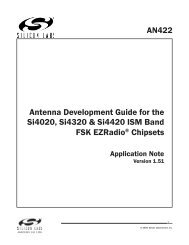C8051F326/7 - Silicon Labs
C8051F326/7 - Silicon Labs
C8051F326/7 - Silicon Labs
You also want an ePaper? Increase the reach of your titles
YUMPU automatically turns print PDFs into web optimized ePapers that Google loves.
<strong>C8051F326</strong>/7<br />
10.5. System and USB Clock Selection<br />
The internal oscillator requires little start-up time and may be selected as the system or USB clock immediately<br />
following the OSCICN write that enables the internal oscillator. If the external clock is selected as the<br />
system or USB clock, then startup times may vary based on the specifications of the external clock.<br />
10.5.1. System Clock Selection<br />
The CLKSL[2:0] bits in register CLKSEL select which oscillator source is used as the system clock.<br />
CLKSL[2:0] must be set to 001b for the system clock to run from the external clock; however the external<br />
clock may still clock certain peripherals (timers, UART, USB) when the internal oscillator is selected as the<br />
system clock. The system clock may be switched on-the-fly between the internal oscillator, external clock,<br />
low frequency oscillator, and 4x Clock Multiplier so long as the selected oscillator is enabled and can provide<br />
a stable clock.<br />
10.5.2. USB Clock Selection<br />
The USBCLK[1:0] bits in register CLKSEL select which oscillator source is used as the USB clock. The<br />
USB clock may be derived from the 4x Clock Multiplier output, internal oscillator divided by 2, or an external<br />
clock. The USB clock source may also be turned off. The USB clock must be 48 MHz when operating<br />
USB0 as a Full Speed Function; the USB clock must be 6 MHz when operating USB0 as a Low Speed<br />
Function. See Figure 10.5 for USB clock selection options.<br />
Some example USB clock configurations for Full and Low Speed mode are given below:<br />
Table 10.1. Typical USB Full Speed Clock Settings<br />
Clock Signal<br />
Internal Oscillator<br />
Input Source Selection Register Bit Settings<br />
USB Clock Clock Multiplier USBCLK = 00b<br />
Clock Multiplier Input Internal Oscillator* MULSEL = 0b<br />
Internal Oscillator Divide by 1<br />
External Clock<br />
IFCN = 11b<br />
Clock Signal Input Source Selection Register Bit Settings<br />
USB Clock Clock Multiplier USBCLK = 10b<br />
Clock Multiplier Input External Clock MULSEL = 1b<br />
Port I/O<br />
12 MHz CMOS Clock INPUTEN = 1b (GPI-<br />
OCN.6)<br />
*Note: Clock Recovery must be enabled for this configuration.<br />
Table 10.2. Typical USB Low Speed Clock Settings<br />
Clock Signal<br />
Internal Oscillator<br />
Input Source Selection Register Bit Settings<br />
USB Clock Internal Oscillator / 2 USBCLK = 01b<br />
Internal Oscillator Divide by 1<br />
External Clock<br />
IFCN = 11b<br />
Clock Signal Input Source Selection Register Bit Settings<br />
USB Clock External Clock USBCLK = 10b<br />
Port I/O<br />
6 MHz CMOS Clock INPUTEN = 1b (GPI-<br />
OCN.6)<br />
76 Rev. 1.1


